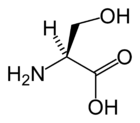
Homology (chemistry)
Encyclopedia
In chemistry
, homology refers to the appearance of homologues. A homologue (also spelled as homolog) is a compound
belonging to a series of compounds differing from each other by a repeating unit, such as a methylene group
, a peptide
residue, etcetera.
 A homolog is a special case of an analog
A homolog is a special case of an analog
. Examples are alkane
s and compounds with alkyl sidechains of different length (the repeating unit being a methylene group -CH2-).
, homologous elements share many chemical properties and appear in the same group (column) of the table. For example, all noble gases are colorless, monatomic gases
with very low reactivity. These similarities are due to similar structure in their outer shells
of valence electrons. Mendeleev used the prefix eka- for an unknown element below a known one in the same group.
Chemistry
Chemistry is the science of matter, especially its chemical reactions, but also its composition, structure and properties. Chemistry is concerned with atoms and their interactions with other atoms, and particularly with the properties of chemical bonds....
, homology refers to the appearance of homologues. A homologue (also spelled as homolog) is a compound
Chemical compound
A chemical compound is a pure chemical substance consisting of two or more different chemical elements that can be separated into simpler substances by chemical reactions. Chemical compounds have a unique and defined chemical structure; they consist of a fixed ratio of atoms that are held together...
belonging to a series of compounds differing from each other by a repeating unit, such as a methylene group
Methylene
Methylene is a chemical species in which a carbon atom is bonded to two hydrogen atoms. Three different possibilities present themselves:* the -CH2- substituent group: e.g., dichloromethane ....
, a peptide
Peptide
Peptides are short polymers of amino acid monomers linked by peptide bonds. They are distinguished from proteins on the basis of size, typically containing less than 50 monomer units. The shortest peptides are dipeptides, consisting of two amino acids joined by a single peptide bond...
residue, etcetera.

Analog (chemistry)
In chemistry, a structural analog , also known as chemical analog or simply analog, is a compound having a structure similar to that of another one, but differing from it in respect of a certain component. It can differ in one or more atoms, functional groups, or substructures, which are replaced...
. Examples are alkane
Alkane
Alkanes are chemical compounds that consist only of hydrogen and carbon atoms and are bonded exclusively by single bonds without any cycles...
s and compounds with alkyl sidechains of different length (the repeating unit being a methylene group -CH2-).
Periodic table
On the periodic tablePeriodic table
The periodic table of the chemical elements is a tabular display of the 118 known chemical elements organized by selected properties of their atomic structures. Elements are presented by increasing atomic number, the number of protons in an atom's atomic nucleus...
, homologous elements share many chemical properties and appear in the same group (column) of the table. For example, all noble gases are colorless, monatomic gases
Monatomic gas
In physics and chemistry, monatomic is a combination of the words "mono" and "atomic," and means "single atom." It is usually applied to gases: a monatomic gas is one in which atoms are not bound to each other....
with very low reactivity. These similarities are due to similar structure in their outer shells
Electron shell
An electron shell may be thought of as an orbit followed by electrons around an atom's nucleus. The closest shell to the nucleus is called the "1 shell" , followed by the "2 shell" , then the "3 shell" , and so on further and further from the nucleus. The shell letters K,L,M,.....
of valence electrons. Mendeleev used the prefix eka- for an unknown element below a known one in the same group.
See also
- Homologous seriesHomologous seriesIn chemistry, a homologous series is a series of compounds with a similar general formula, possessing similar chemical properties due to the presence of the same functional group, and showing a gradation in physical properties as a result of increase in molecular size and mass...
- AnalogAnalog (chemistry)In chemistry, a structural analog , also known as chemical analog or simply analog, is a compound having a structure similar to that of another one, but differing from it in respect of a certain component. It can differ in one or more atoms, functional groups, or substructures, which are replaced...
- Congener
- Structure-activity relationshipStructure-activity relationshipThe structure–activity relationship is the relationship between the chemical or 3D structure of a molecule and its biological activity. The analysis of SAR enables the determination of the chemical groups responsible for evoking a target biological effect in the organism...

